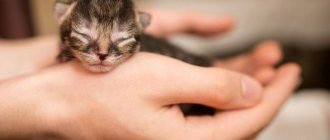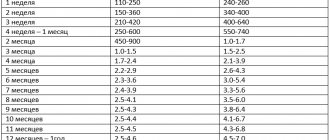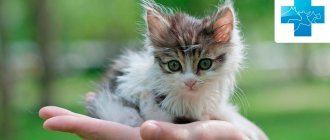Home » Useful Information
Weight gain during the period of active growth of a kitten plays a big role. Monitoring this indicator is important so that deviations can be noticed in time and the causes that caused them can be eliminated. To make it easier to keep weight characteristics under control, you can use special tables.
- 2 Why do you need to monitor a kitten’s weight at different periods of its growth?
2.1 What is a weight diary
- 3.1 Video: how to weigh a cat
- 4.1 Table: average body weight of kittens in the first 6 months of life
What can a kitten weigh at birth?
The weight of a kitten at birth can depend on various characteristics:
- Gender. At the moment of birth, a cat may not differ in weight from a female cat, but this difference becomes noticeable after some time. Males are usually a little larger than female cats, and therefore weigh a little more.
- Number of kittens born. It has long been noted that the more numerous the litter, the greater the underweight of each individual.
- The completeness of the diet of a mother cat during pregnancy.
- Belonging to a certain breed. For example, a Maine Coon kitten at the time of birth will weigh more than a baby, for example, of the Siamese breed.
Newborn kittens of large breeds (for example, Maine Coons) will weigh more than their graceful relatives
A newborn kitten most often weighs no more than one hundred and twenty grams. He is still blind and mostly immobilized. All he can do is eat, grow and get enough sleep. Staying in this mode, the baby can gain up to 15 grams per day.
Dangerous symptoms
Poor nutrition, lack of activity and weight control lead to overeating or undereating in cats. An outbred individual is able to independently control the amount of food eaten. Pedigree cats and animals in adulthood are characterized by a weak instinct towards food. Excessive eating leads to obesity.
The following symptoms help to recognize the disease: fat deposits, fatigue, apathy, lack of interest in games and shortness of breath. A malnourished cat is characterized by poor weight gain, bone visualization, and frequent illness. The presence of one or more symptoms requires immediate consultation with a veterinarian.
https://youtube.com/watch?v=JVUSdTd8OGQ
Why do you need to monitor a kitten’s weight at different periods of its growth?
A kitten's weight is a very important aspect of its development. The baby's weight needs to be monitored for several reasons. For example, by the age of one month, a kitten can weigh up to 500 grams. If his weight differs from this indicator in the direction of decrease, this may be caused by the following reasons:
- diseases, congenital or acquired;
- numerous litters;
- the mother’s lack of a complete diet that can provide nutrition for both the cat herself and her babies.
During the feeding period, the cat's food volume should be increased by 30% of the normal daily intake.
An underweight kitten may indicate that the baby is malnourished. He becomes lethargic, sleeps a lot, and apart from the general mass of kittens. In this case, you need to increase the amount of food for the nursing cat and monitor how long the weak baby stays at her breast.
Once I brought foundlings to my nursing cat. They were left without a mother, and besides, unkind people simply abandoned them to their fate. The two babies quickly got used to it, actively sucked the cat and did not differ from her “native” kittens. One kitten was very weak, he could not defend his place at the nipple and was often left out of work. Sometimes he still managed to get comfortable, but he quickly got tired and soon fell asleep without having eaten enough. Since I closely followed the adaptation of foundlings, I immediately noticed this (literally within 24 hours). The baby had to be fed separately. I gave him a special mixture, but also tried to get him to latch on to the cat’s breast more often (the more lively brothers had to be pushed aside for a while). As a result, this baby still lagged behind the others in weight, but caught up with them in height by about a year.
If a kitten is diagnosed with any disease, then to correctly calculate the medicinal suspension you will also need to know the exact weight of the animal. Therefore, a conscientious owner always monitors this indicator.
What is a weight diary
Every caring owner should keep a kitten's weight diary. This must be done regardless of whether the kitten grows up alone or with its mother cat and brothers. It is necessary to record all weight indicators in the diary, which can later help track whether the baby is developing normally.
The weight diary can be kept in any form, as convenient for the owner. This is an ordinary notebook for me. In it I write down the date of birth of the kittens, the names I gave them, as well as everything related to caring for them. This is not only their weight, but also the dates of treatment for fleas and worms, as well as the dosage of drugs (which, by the way, depends on weight). This is very convenient because over time I forget when, for example, I processed animals. A hint notebook helps me remember, especially since I now have 4 cats and a dog, so it’s quite possible to forget or confuse something.
Character of Siberian cats
The character of Siberian cats was influenced by the harsh climate of the northern regions of Russia. These animals have very good health. They have a strong and decisive character and adapt well to any new home (be it an apartment or a country house).
Siberians become very attached to their owners, but do not impose their feelings on them. These animals, which seem clumsy and lazy because of their fur, are actually very dexterous, lightning fast and very active. They adore children and get along well with other animals, but you should not keep Siberians together with rodents, birds and fish.
The strong hunting instinct of these cats can lead to dire consequences.
How to weigh a kitten correctly
If the kitten is very small, then in order to weigh it, you can use a regular kitchen scale and a small box. To prevent the kitten from turning weighing into a game, the best time for the process is immediately after sleep. If the baby starts spinning and jumping, the indicators will be inaccurate. Trying to hold a playful baby with your hand can also get a distorted result.
To get the most accurate figure for the baby’s weight, you can follow two methods:
- First, weigh the box, then put the kitten in it and record the result again. Subtract the difference.
- Place the box on the scales, and only then turn them on. They will show zeros. After this, we put the baby in a box and get the figure for his body weight.
It is more convenient to weigh mobile kittens in small containers or boxes to get a more accurate result.
This way the owner will receive an exact figure in grams, which can be entered into the animal’s weight diary.
Video: how to weigh a cat
How much does a cat weigh and developmental features?
1 month
An average monthly cat weighs 400-500 grams. He actively begins to explore the world, crawls out of the box on his own, and gets acquainted with adult food. At this age they love to play and sleep often, but little.
At 1.5, babies' eye color changes. They begin to look for the tray on their own and visit it regularly. This is a good age to look for new owners.
2 months
Pet weight 450-900 g.
At this age, kittens have heightened curiosity - they explore the world around them, try everything with their teeth and paws.
Playful, affectionate. Their outlines take on those of an adult cat.
Two-month-old kittens are already accustomed to combing, washing and trimming their nails.
3 months
The weight of the cat is 1000-1500 g.
He is already playful and affectionate, accustomed to his owner and affection. Responds to a nickname, independently finds a tray, bowls of food and water.
Three-month-old kittens have fully formed eye color, as well as baby teeth.
By this age, boys surpass their sisters in size.
4 months
Hang 1700-2400 gr.
Kittens become less playful, although they like to chase toys around the house. They become like adult cats: they sleep more, go to the bowl less often, and become calm and affectionate.
The replacement of baby teeth with permanent ones begins.
They hang 2200-2900 gr.
Kittens are slightly smaller than an adult cat. At this age they are transferred to three meals a day.
Half a year
Hang 2300-3600 gr.
Six-month-old cats have finished changing their teeth.
They are proportionally harmonious and graceful in their movements. Hunting instincts are developed.
At 6 months, kittens end their active growth phase and gain significantly less weight.
7 months
Hangs 2400-3900 g.
Males and cats begin their first molt and puberty. If a girl and a boy live together, then they begin to be interested in each other, and the males court the females.
Now the pet needs regular brushing so that the fur it licks off does not cause stomach upset.
8 months
Hangs 2500-4100 g.
At this age, it is recommended to spay and neuter cats if they are not planned for breeding.
2500-4300 gr.
At this age, kittens look like adult cats and gain almost no weight.
10 months
Hangs 2500-4400 g.
At this age, cats begin their first heat.
It is not recommended to breed cats before 12 months of age to avoid birth complications.
From the age of ten months, kittens participate in exhibitions in adult categories.
11 months
Hangs 2500-4500 g.
A fully formed adult animal that has stopped growing. Now you can switch your pet to adult food.
Year
Hangs 2500-4600 g.
Already an adult animal that eats food for adult animals is able to participate in mating and exhibitions.
Some breeds are fully mature by age two, such as Maine Coons.
What are the norms for weight gain for kittens?
The first six months of a kitten's life are the most active in terms of growth. Accordingly, if the baby is healthy and develops normally, he will regularly gain weight:
- Before the baby turns 1 month old, he rapidly gains weight - about 15 g per day. At the same time, by the end of the 1st week, the kitten should double its birth weight. Weigh him daily during this period.
- From 1 to 2 months, weight gain occurs systematically, on average 100–150 g per week. Weigh the baby once every 3 days.
- After 2 months, weight gain varies from person to person. It depends on the breed and nutrition of the animal. He is weighed weekly for up to 6 months, then once a month for up to a year. It is important that there is weight gain. If it is absent, you should contact your veterinarian to find out the reasons.
Since there are no exact indicators of body weight gain (much depends on the individual characteristics of the animal, its living conditions and diet), the owner should focus on the average weight standards for kittens.
Table: average body weight of kittens in the first 6 months of life
| Age | Weight |
| 1–6 days | 70–130 g |
| 7 days | 85–200 g |
| 7–14 days | 225–400 g |
| 14–21 days | 285–500 g |
| 1 month | 500–750 g |
| 2 months | 1000–1500 g |
| 3 months | 1700–2300 g |
| 4 months | 2500–3600 g |
| 5 months | 3100–4200 g |
| 6 months | 3500–4800 g |
Short-term stabilization of weight in a kitten
The phenomenon of short-term weight stabilization often occurs. There is no need to panic if the kitten’s weight gain “frozen” for several days, and then continues in the same progression.
Such an anomaly can manifest itself at any time stage of the baby’s life. It often occurs when there is a transition from breastfeeding to regular food (dry food or natural food). This is due to the fact that the baby’s body goes through a period of adaptation to receiving new nutrients.
However, you should worry if there are no changes for more than a few days (for example, a week). This may mean that the kitten is malnourished or sick or infected with parasites. You should visit a veterinarian as soon as possible if, after weight stagnation, body weight begins to decrease rather than increase.
Table: kitten weights by month (values for popular breeds)
| Kitten age | Maine Coon cat weight (g) | Maine Coon cat weight (g) | British cat weight (g) | British cat weight (g) | Scottish cat weight (g) | Scottish cat weight (g) |
| Newborn kitten | 120–140 | 120–160 | 60–140 | 70–140 | 60–140 | 70–140 |
| 1 Week | 180–230 | 200–260 | 110–250 | 240–260 | 110–250 | 240–280 |
| 2 week | 280–340 | 400–360 | 150–360 | 340–400 | 140–360 | 340–400 |
| 3 week | 420–550 | 440–600 | 210–420 | 400–630 | 200–420 | 390–630 |
| 4 week | 560–680 | 630–750 | 250–600 | 550–740 | 240–600 | 540–740 |
| 2 months | 1100–1400 | 1200–1500 | 450–900 | 1000–1700 | 400–900 | 1000–1700 |
| 3 months | 1700–2300 | 1800–2300 | 1000–1500 | 1500–2500 | 1000–1500 | 1500–2500 |
| 4 months | 2700–3600 | 3000–3800 | 1700–2400 | 2100–3900 | 1700–2400 | 2100–3900 |
| 5 months | 2900–3900 | 3000–5500 | 2200–2900 | 2600–4300 | 2200–2900 | 2600–4300 |
| 6 months | 3200–4000 | 3900–6000 | 2300–3600 | 3000–5400 | 2300–3600 | 3000–5400 |
| 7 months | 3500–4100 | 4200–6500 | 2400–3900 | 3300–5600 | 2400–3900 | 3300–5600 |
| 8 months | 3800–4300 | 4500–6900 | 2500–4100 | 3500–6000 | 2500–4100 | 3500–6000 |
| 9 months | 4100–5000 | 5000–7000 | 2500–4300 | 3800–6400 | 2500–4300 | 3800–6400 |
| 10 months | 4200–5500 | 5200–7700 | 2500–4400 | 4100–6700 | 2500–4400 | 4100–6700 |
| 11 months | 4300–6000 | 5700–8000 | 2500–4500 | 4300–6800 | 2500–4500 | 4300–6800 |
| 12 months | 4500–6300 | 5700–9000 | 2500–4600 | 4500–7000 | 3500–4600 | 4500–7000 |
How to determine weight standards for a mongrel kitten
When it is not possible to determine what breed a kitten is, it is necessary to use average indicators. The size of the baby will change in accordance with its development. There are a number of factors that allow you to predict a kitten’s weight gain. For example, when he switches from breast milk to a normal diet, the weight may decrease slightly.
After the 6th month of life, weight gain is not of decisive importance. If the cat is active, eats well, and has no problems visiting the litter box, then there is no need to worry too much. The veterinarian should be observed on a schedule determined by the doctor (basically it coincides with the vaccination schedule).
Having mongrel cats and a dog adopted from the street, I regularly visit the veterinarian. All my animals have veterinary passports, are vaccinated and sterilized. This way I protect not only them, but also my family. After all, some diseases (and at least the same worms) can be transmitted to humans. Since my children play with animals, I have a strict order in this matter.
Necessary care
When becoming the happy owner of a 3-month-old Scottish Fold (low-eared) or Scottish Straight (straight-eared), a person must consider the following:
- Quality of licking. The kitten tries hard to get its fur in perfect order, but it does not always have the perseverance to do it efficiently. If the owner helps with cleaning and combing the fur, then you should still teach him to wash the baby’s “buttocks” himself - sometimes lubricate the area under the tail with fish oil or vegetable oil.
- Upbringing. Three-month-old Scots, having just gotten used to it, begin to rush around the house “as if stung,” “attack” the owner’s legs and utter war cries. This is normal behavior for a kitten, but you need to start correcting his behavior - accustom him to a scratching post, discourage him from climbing on the kitchen table and “dining” with indoor flowers. The animal is not beaten or punished - they only scold in a stern voice, show the correct behavior (take it to a scratching post, cat grass), and ignore it for a while.
- Bathing and brushing. Three months is the ideal age to accustom a kitten to grooming and bathing procedures. His psyche is very plastic - the baby will soon get used to these unusual actions. The owner acts calmly, does not shout, speaks kindly, and rewards his efforts with “yummy treats.” It is already very difficult to accustom an adult, wayward “Scot” to such procedures.
- Vaccination. As a rule, the initial stage of the first vaccination remains on the conscience of the breeder. Then the owner brings his lucky acquisition to the veterinarian for an initial examination - the doctor prescribes an anthelmintic. After 10-14 days, the baby will be vaccinated again and a veterinary passport will be issued (if there is no document).
- Fortification. The kitten is actively developing - it does not have enough microelements from food. Therefore, the owner offers the “Scot” vitamin supplements with calcium and taurine. What remedy a particular kitten needs is determined only by a veterinarian.
What to feed babies
The best food for small kittens is cat milk replacers. However, they are quite expensive, and it is not always possible to find a fresh product. In such cases, a good option for complementary feeding would be:
- Goat milk – pre-boiled and diluted 50% with clean water. Adding a teaspoon of sugar and egg yolk (per 0.5 liters of milk) will help enrich the product with useful substances and vitamins.
- Infant milk formulas , however, it is important to pay attention to the fact that they do not contain various fillers, dyes, flavors, and sugar. The mixture is prepared according to the instructions, in proportions as for a child aged 1-2 weeks. But before feeding, the finished product is half diluted with water.
- Formulas for infant kittens are ideal because they are similar in composition to mother's milk. Only, of course, preference should be given to quality products from trusted brands and src=”https://porodakoshki.ru/wp-content/uploads/2019/08/Kak-kormit-kotyat-v-2-nedeli-e1565139834249.jpg” class=”aligncenter” width=”600″ height=”400″[/img]
Cat milk replacers are available in both powder and liquid forms. They are quite easy to prepare, especially since each product package comes with instructions that help not only decide on the recipe, but also choose the optimal daily dosage. This product can be used for complementary feeding in cases where a nursing cat does not have enough milk or as babies grow older.
Feeding mode
The feeding regimen for orphaned two-week-old kittens must be observed constantly, 24 hours a day. Feed your babies by the hour, at the same time, without disturbing the schedule either during the day or at night. It is precisely this aspect that determines the life and development of artificial kittens.
If at one week of age kittens eat every 2-2.5 hours without a break for night sleep, starting from two weeks, they are fed the same way both day and night, but every three hours. That is, they should receive food six to seven times a day. The food norm per 100 grams of kitten weight is 30-35-40 grams.
From three weeks, kittens are fed every 4-4.5 hours. At night - once every five to six hours. Babies require 46-48 ml of food per 100 grams of weight.











